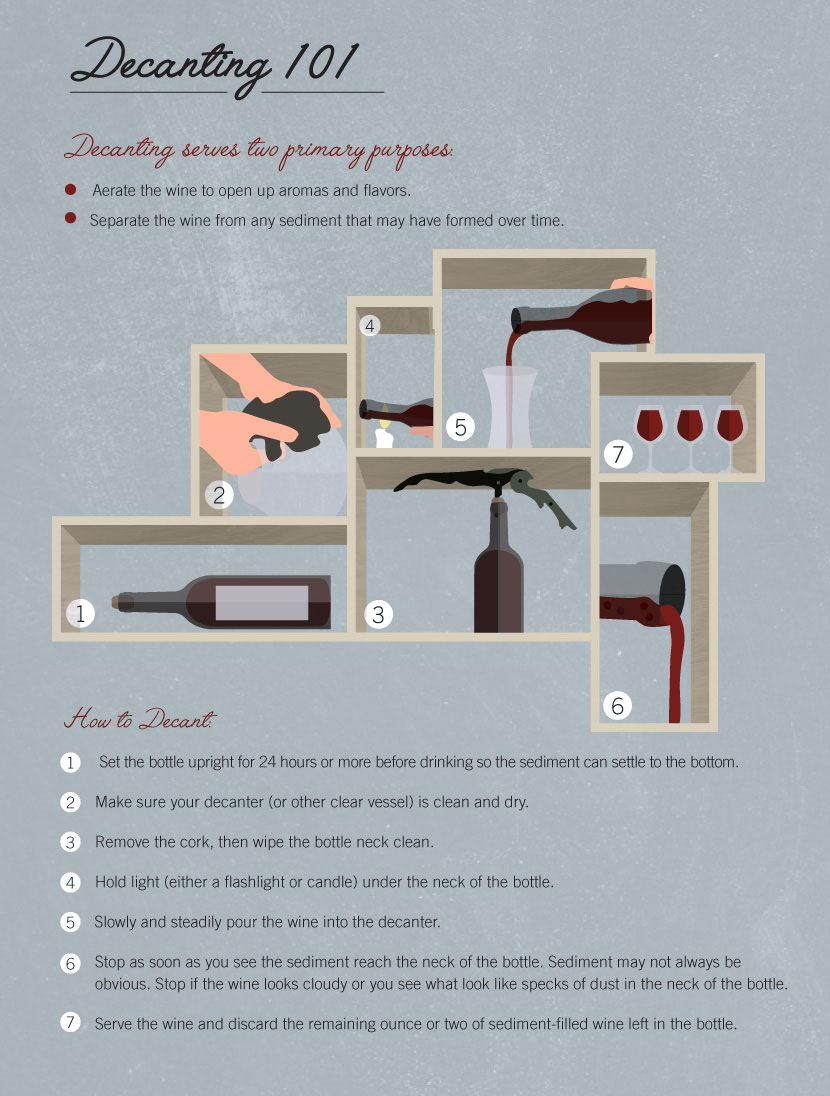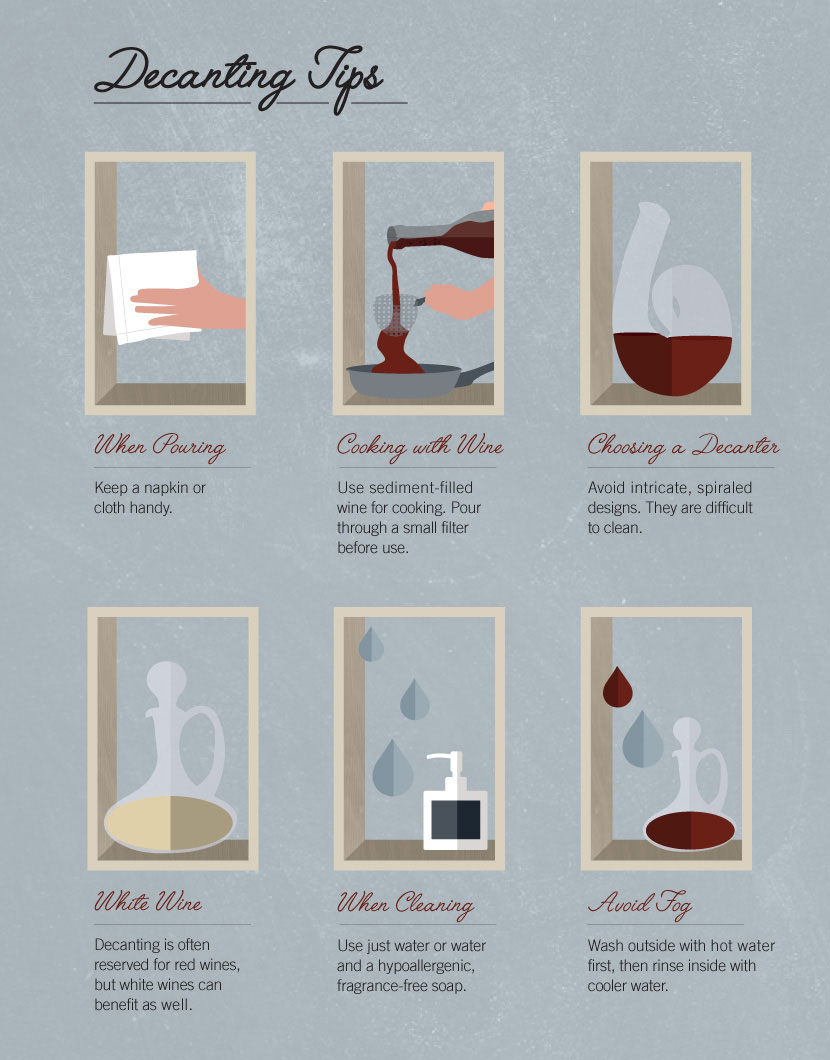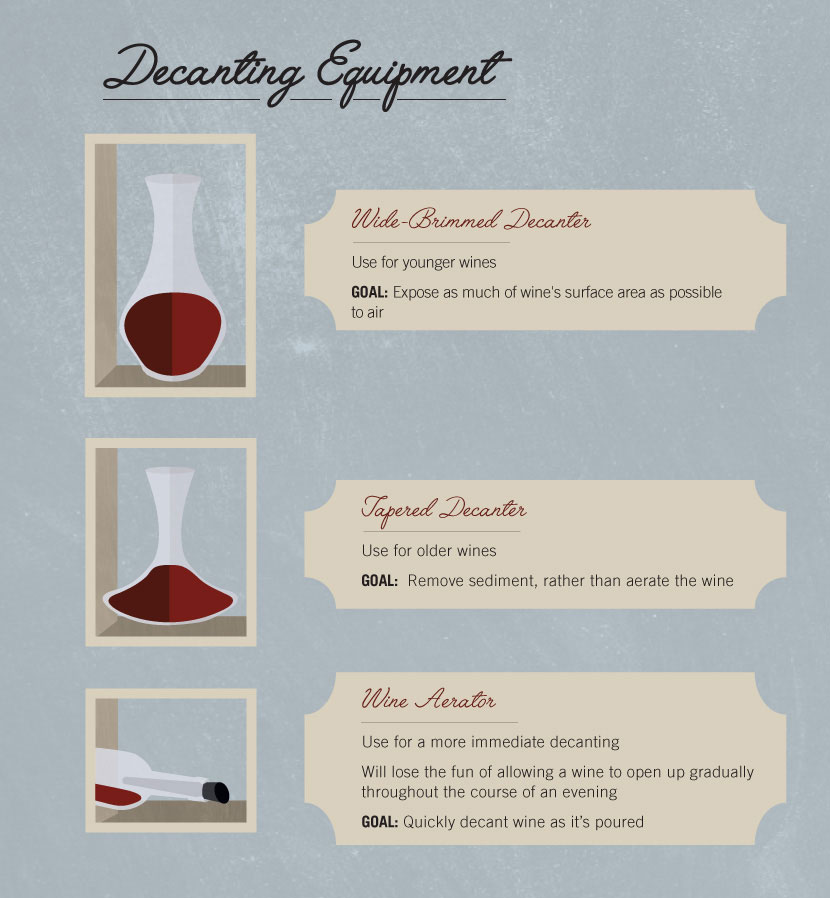When, Why, and How to Decant Wine
To decant or not to decant? With apologies to Shakespeare, this is so often the question on the minds of wine lovers, for whom the time-honored practice of decanting a favorite bottle of wine can feel baffling and intimidating.
Although it may seem unnecessarily fancy and stuffy – or best left to professional sommeliers and serious collectors with hundreds of expensive bottles in their cellars – the ritual of decanting wine isn’t at all complicated or mysterious. It can be accomplished easily in the comfort of your own home, whenever the occasion arises.
It’s not so much the act of decanting (pouring wine into a separate container in order to expose the surface of the liquid to oxygen) that confuses people, but rather the question of why and when to do it. Once you understand the basic logic behind the custom, you’ll find it couldn’t be simpler, and may even enhance your appreciation of a special bottle.

Which Kinds of Bottles Need to be Decanted?
As important a role as decanting plays in the appreciation of wine, not all bottles require it. In fact, the overwhelming majority of wine produced today is intended for immediate “pop and pour” consumption, and requires no decanting. So which bottles ought to be decanted and which can go without?
Generally, it is customary to decant wines that fall on two extreme sides of the aging spectrum. As Charles Antin, Specialist Head of Sale and Associate Vice President of the Christie’s Wine Department, puts it: “I often decant wines that are either a bit too young, or at peak maturity. That said, as with all things wine, there’s no right answer. My advice is, when in doubt, decant. It’s rarely bad for the wine.”
True as this may be, it’s important to understand the fundamental principles behind the process as they apply to the specific bottle you have in mind – whether it’s young and powerful or more delicate and mature.
Decanting Young Wine
Hefty, age-worthy wines that may otherwise seem too young and tight, such as a big Bordeaux, Barolo, or Napa Cabernet, often benefit from some time in a decanter. Although these types of wines ideally would be gradually exposed to oxygen by many decades of aging in a cellar, not everyone has the time (or patience) to wait around to drink these impressive bottles.
Decanting a young wine is often necessary to allow the otherwise harsh tannins – the chemical compound found in red wines that gives them their specific grippy, mouth-puckering quality – to round out and become less severe. The exposure to oxygen tends to soften up this tannic structure, enhance a wine’s aromatics, and allow the underlying fruit flavors of the wine to come forward, making wines that may be considered a bit shut down or closed (wine-world synonyms for too young) more immediately accessible. This is what it means to allow a wine to open up or breathe. Decanting greatly accelerates that process.
Again, it should be noted that this is really only necessary for young, brawny wines that will only enter their optimal drinking window after several years (or more) in the bottle. If you aren’t sure whether this applies to the example you’re planning to serve with dinner, there’s a simple test: Pour yourself a taste. If the wine in your glass seems a bit too harsh or angular, obscured by the firm structure of its tannins, then try pouring it into a decanter. Not only are the results likely to surprise you, but it can be fascinating and fun to taste the wine at various stages as it opens up and develops over the course of several hours.
Decanting Mature Wine
On the opposite end of the continuum are wines that have reached their peak maturity, particularly if they are more than 10 to 15 years old. Although it may seem counterintuitive to expose such mature wines to oxygen (since they have long since evolved past their youthful immature phase) in this situation the process of decanting serves a different purpose.
Over time, as a bottle of wine sleeps in a cellar, it is common for a deposit of sediment to form inside. While this is completely natural and entirely harmless, it can impart a bitter and astringent taste, so precautions should be taken to remove the sediment before consumption.
“The best thing to do is to let the bottle stand upright for a few hours for the particles to settle, and then decant it slowly so that the sediment is left in the bottle,” Antin says. Traditionally, it was customary to decant an older wine with the neck of the bottle held above a candle (although a flashlight works perfectly well), to keep an eye out for the sediment as the wine transfers into the decanter. When the first wisps of sediment enter the neck of the bottle, immediately stop pouring. You’ll likely be left with a small amount of sediment-filled wine in the bottle, which should be discarded.
Generally, you don’t need to wait a long time for an older wine to breathe in the decanter, and since excess oxygen can spoil particularly delicate examples, it is best to serve mature bottles immediately after decanting them. However, mature wine can sometimes be a bit closed or musty right after the cork is popped. If you’ve ever spent a long time cramped up in a small space (an economy-class airplane seat, for instance), you can probably sympathize with the condition of a wine that has spent years, or even decades, in a bottle: They sometimes need little room to breathe and stretch their limbs. In this way, it isn’t at all uncommon for an older wine to benefit from a bit of time in the decanter. But if the wine tastes delicious right away, there’s no need to wait too long. Again, the taste-as-you-go approach works best.
What About Whites?
Decanting is typically reserved for red wines. But there are a handful of whites – generally richer, more aromatic, and fleshier – that greatly improve after some time in the decanter.
Antin often decants white wines. “If you open a bottle and the aromatics are reticent, pouring the wine into a decanter can often help,” he says. “Some of my favorite white wines to decant are from the northern Rhone and the Loire Valley.”

What You’ll Need
Decanting a bottle of wine doesn’t require much in the way of fancy equipment. All you need is a decanter, which comes in any number of shapes and sizes.
For younger wines, it’s preferable to use a wide-brimmed decanter, such as the Wine Enthusiast Vivid Wine Decanter. The idea is to expose as much of wine’s surface area to air as possible. For older wines, a more tapered shape is preferred, such as that of the Riedel Cabernet Decanter. In this case the point is merely to remove sediment rather than aerate the wine.
But there’s really no need to purchase a special decanter. In a pinch almost any clear vessel will work just fine – a water pitcher, an empty vase, or even the container of a blender. Whatever receptacle you decide to use, just make sure it’s clean and dry before you pour in the wine.
 e
eYou may also be tempted to experiment with one of the many different brands of aerators available. This tool is designed to “flash decant” the wine as it’s poured into the glass. Part of the joy of decanting, however, is allowing wine to gradually open up and transform over the course of an evening, and tasting it at each step of its evolution. Although aerators may get the job done quickly, they also diminish this particular aspect. Ultimately, it’s a matter of personal taste.
 Article by
Article by
Zachary Sussman



 0
0